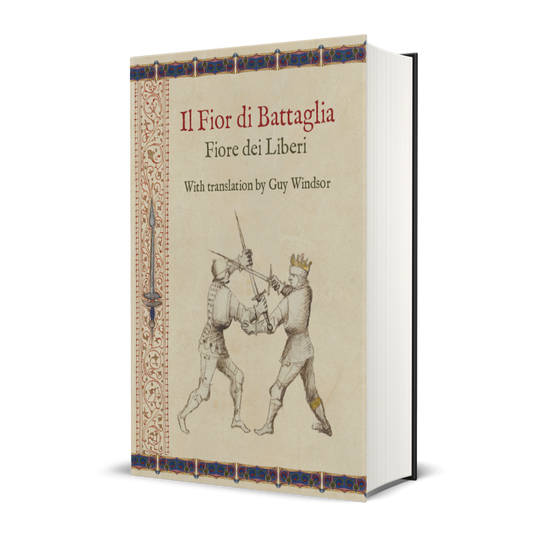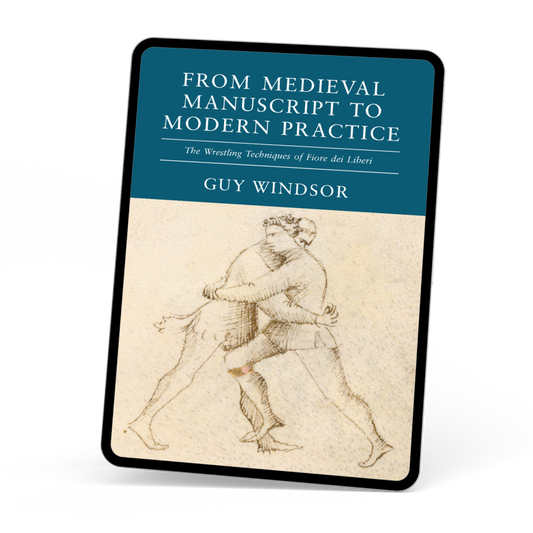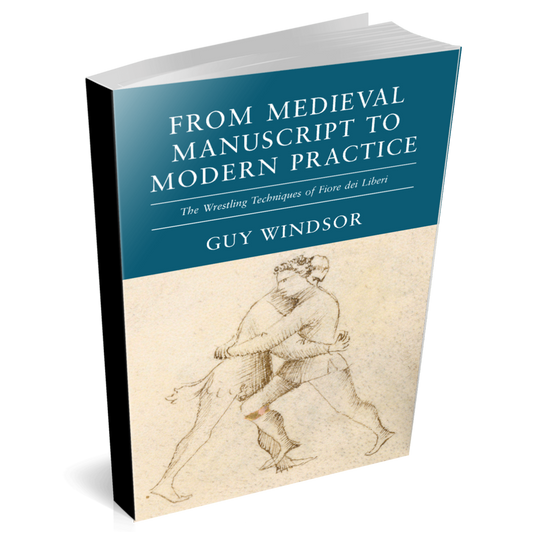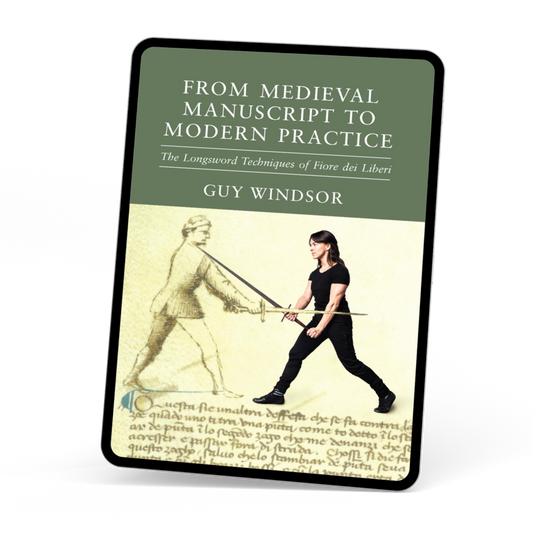
Episode 179: Horse Armour at the Royal Armouries, with Eleanor Wilkinson-Keys
Share
You can also support the show at Patreon.com/TheSwordGuy Patrons get access to the episode transcriptions as they are produced, the opportunity to suggest questions for upcoming guests, and even some outtakes from the interviews. Join us!
Today’s episode is with Eleanor Wilkinson-Keys, who is Assistant Curator of Arms and Armour at the Royal Armouries Museum in Leeds. She has an MA in Medieval Studies from the University of Leeds, and works with the European armour and edge weapons collections, which makes us all extremely jealous, and the Asian and African collection which also makes us extremely jealous. She works there with Natasha Bennett, who you may recall from Episode 82.
In our conversation, we talk about how Eleanor got into her career and why a jousting helmet sparked her interest in working at the Royal Armouries. Ellie’s particular interest is in later jousting, when the kit got really weird and wonderful. We chat about some of the fantastic decoration on both the horses’ and knights’ armour, such as dragons, snails with wings, and even squirrels.
We also talk about the best way to visit a big museum where there is just too much to see. Ellie tells us which pieces at the Royal Armouries she would make a beeline for.
Finally, Guy sets Ellie a challenge, and if you are looking at this after 28th November 2024, you’ll be able to see the results of that challenge!
Photos:
Photo credit: Copyright © Royal Armouries
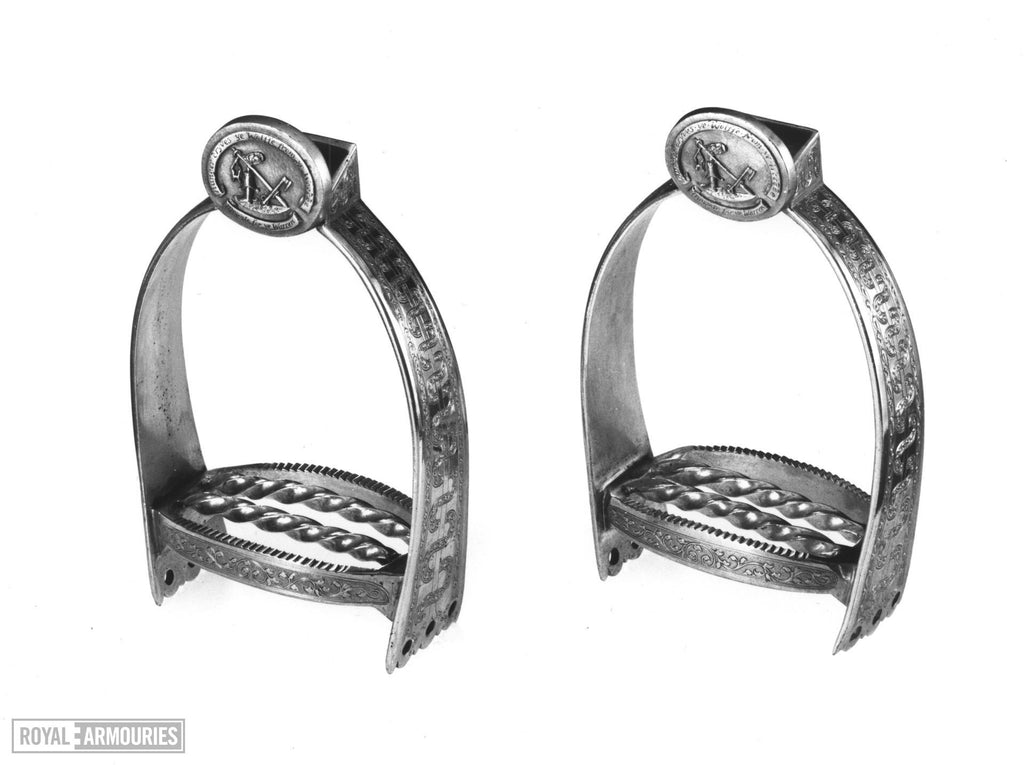
https://royalarmouries.org/collection/object/object-20471
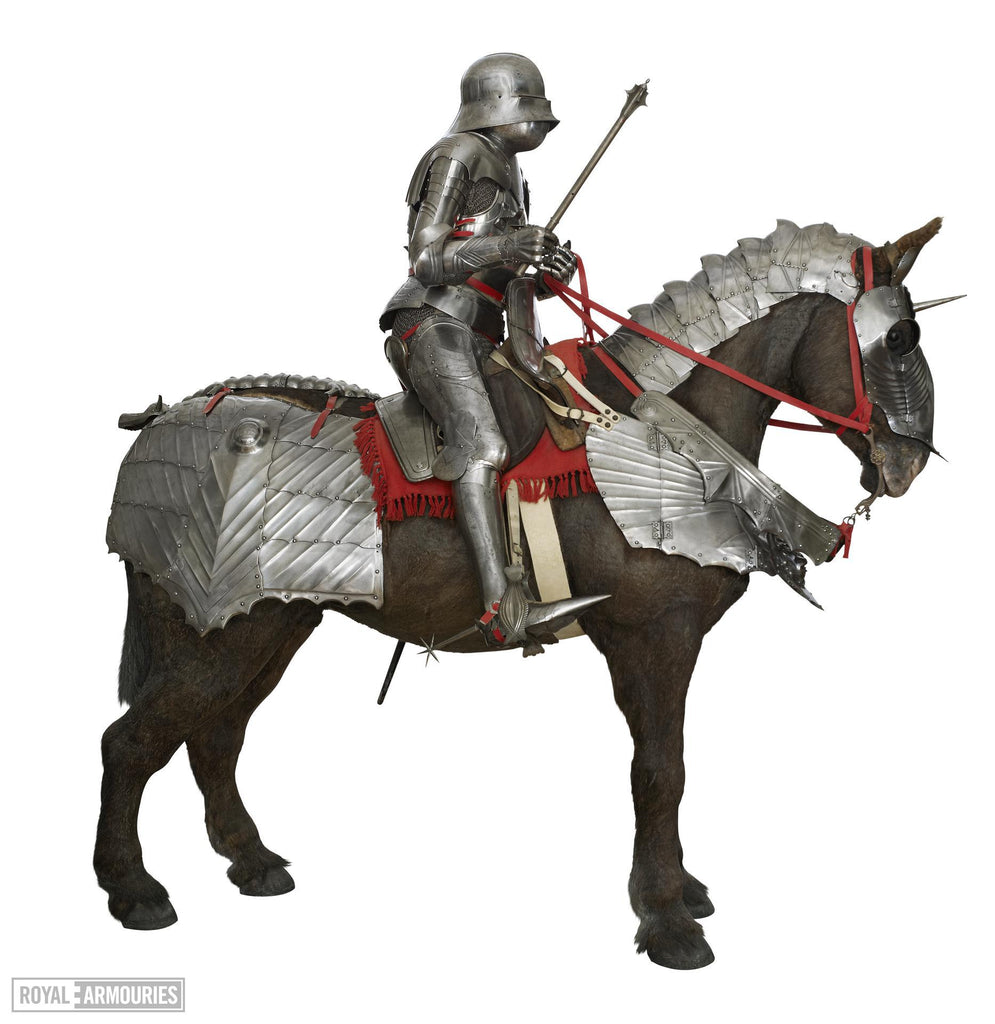
https://royalarmouries.org/collection/object/object-1292
I recommend you click the links to view multiple pictures of the items on the Royal Armouries website.
Transcript
Guy Windsor
I'm here today with Eleanor Wilkinson-Keys, who is Assistant Curator of Arms and Armour at the Royal Armouries Museum in Leeds. She has an MA in Medieval Studies from the University of Leeds, and works with the European armour and edge weapons collections, which makes us all extremely jealous, and the Asian and African collection which also makes us extremely jealous. She works there with Natasha Bennett, who you may recall from Episode 82. So without further ado, Ellie, welcome to the show.
Eleanor Wilkinson-Keys
Hello. Hi. Thank you so much for having me. It's very exciting.
Guy Windsor
It's lovely to meet you. So I ask everyone this: whereabouts in the world are you? I’m guessing Leeds?
Eleanor Wilkinson-Keys
I'm here at the museum, the Royal Armouries Museum in Leeds in West Yorkshire. And if you're not familiar with the shires of the UK, anybody listening, we’re up in t’north.
Guy Windsor
Excellent. Yeah, so sort of about four hours south of Edinburgh, and about four hours north of my house.
Eleanor Wilkinson-Keys
Oh right. So perfectly in the middle of those. Yeah.
Guy Windsor
I mean, when we moved to the UK, I did sort of quietly suggest that Leeds might be a good choice, because there might be a certain museum I might want to visit occasionally. But there were unfortunate family circumstances that made that an impractical choice.
Eleanor Wilkinson-Keys
Yeah. I feel very lucky that the Armouries has been on my doorstep from childhood.
Guy Windsor
You're from Leeds?
Eleanor Wilkinson-Keys
I'm from the Wakefield district. So Leeds is not too far. And I first visited the Armouries in 2005 and I actually have the daily sheet here with me that I have saved from 1st September 2005. My first visit when my dad brought me.
Guy Windsor
You must have been a kid.
Eleanor Wilkinson-Keys
Yes, I was 15.
Guy Windsor
And you had no idea that you are going to be spending your working life there.
Eleanor Wilkinson-Keys
Yeah, absolutely. No idea at that time that I was interested in this subject. I had always been interested in history. But yeah, I would never have guessed looking back on that day out with my dad that I was going to be working here and just living the dream.
Guy Windsor
Was it that day out that that sort of made you think, arms and armour?
Eleanor Wilkinson-Keys
Well, I feel bad for saying no, it wasn't that day out. It probably contributed. I consider myself quite late to the arms and armour party. I didn't really become interested in this subject or, I should probably say, I didn't really engage with this subject, until I was doing my Masters at Leeds. I've always been interested in history, but my degree was in English and Linguistics. And then I decided to do the Masters at Leeds, really great course. And in the second year, because I was doing it part time, there was a module that was run here at the Armouries on medieval tournament. And it was run by Dr. Alan Murray, who is the Senior Lecturer in Medieval Studies at the University of Leeds, and Dr. Karen Watts, who at the time was the senior curator of armour and art here at the museum, and who is now a Curator Emeritus, and they ran this module here at the museum. And in one of the seminars, that was my first detailed look at European Martial culture, anything like that, certainly arms and armour. And in one of the seminars, Dr. Watts brought out a jousting helmet for us all to have a go at handling, to really interrogate the object. And that was the first time I had really engaged with a historical object properly. It sounds such a cliche, but it was a real zing moment for me where I thought, oh, wow, okay, I get it now. I see why people like this. So yeah, it was amazing.
Guy Windsor
There is nothing like handling an original. It’s magic.
Eleanor Wilkinson-Keys
Absolutely not. And just the whole kind of 360 degrees dynamic experience of being able to look at an object face to face, to see how heavy it is. I mean, you will know all about that. And your students and things but it's completely different. Looking at objects in in cases is great, but being able to really touch and feel and look at it is just completely different. And that was the moment that I thought okay, this is an interesting area.
Guy Windsor
In 2006 when I got married, the day before the wedding, because I had friends coming over from Europe and America and places for the for the wedding and most of them are sword people. At that time, David Edge was curator at the Wallace Collection in London. And he very kindly arranged a weapons handling session for my guests. So about eight of us went into a little room in the back of the Wallace Collection, and David had brought up a bunch of really cool swords. Yeah, we just like geeked out for a couple of hours, going “You got to try this one. It's amazing.”
Eleanor Wilkinson-Keys
Yeah, absolutely. It really does. I love doing handling sessions, particularly with people from the historical martial arts world, because I don't do that. So I'm not always looking at arms and armour from the perspective of wearing it or using it or fighting with it. So it's really interesting to discuss with other people who, you know, they pick up the sword, and they know how this would feel to use it. And that's really interesting as well.
Guy Windsor
So you did an MA in Medieval Studies from University of Leeds, what does that involve? Museum training?
Eleanor Wilkinson-Keys
No. In Medieval Studies the only sort of engagement with museums more formally at that point was the module here at the Armouries. And then, immediately after that class with the jousting helmet, I applied to do an internship here that was being advertised at the Armouries, and happily, was successful. And so I worked closely with Dr. Watts, on an internship, and that was a first look at museums and how museums work and what's involved in a curatorial element. So it was exciting, but also daunting, because on the one hand, I'd kind of figured out, okay, this is something I'd really like to do. I'd like to go into curatorial work. But at the same time, how do you get into that? I've been spoiled as well, because having the internship with Dr. Watts and having the Armouries close to home, I didn't want to work anywhere else. So I actually went to work for Wakefield Council, my local council, at Pontefract Castle, and I managed a volunteer scheme there. Absolutely loved it. And that really gave me an insight into a career in museums and the sort of more broad view of what is involved in these kinds of institutions and heritage sites. And I worked there for a few years, I went on to run a volunteer scheme across Wakefield council’s other heritage sites. I managed volunteers. I was really heavily involved in engaging local people in caring for the castle, in getting involved in activities, event days, anything that was that essentially facilitated members of the public interpreting and engaging and enjoying Pontefract Castle. And then later it was across the other heritage sites that are in the care of Wakefield Council. So it was really exciting role. I absolutely loved it. I made a very good friend there, my previous manager Ian Downs who was the senior heritage officer there and his enthusiasm, both his enthusiasm and Karen Watts’s enthusiasm for this subject area and history generally, because Ian is really interested in local history and Pontefract Castle, Sandal Castle, it's so exciting to hear somebody talk about something that they're interested in. And both of them, actually, I think this is maybe why I stuck with trying to get into this is that both of them made me feel that not only was this subject’s exciting, but they were excited that I was excited by it. I think that's really special. To feel like you're welcome in the group.
Guy Windsor
So, is that why you went and did the MA?
Eleanor Wilkinson-Keys
I did the MA mainly because I didn't know what I wanted to do. I'm very I'm happy to admit that I'm the sort of I was the teenager who flitted through wanting to be a vet, wanting to be a fashion designer, wanted to be an air traffic controller.
Guy Windsor
An air traffic controller? Why an air traffic controller?
Eleanor Wilkinson-Keys
As well, as a teenager, I was an Air Cadet.
Guy Windsor
Do you fly planes?
Eleanor Wilkinson-Keys
Sort of, I mean, you can have the controls for a minute.
Guy Windsor
Regular listeners to the show will know this. And clearly you don't. I am nuts about flying planes, I’ve got thirty-three hours of flying training so far, including about ten solo. So I've actually been talking to air traffic control. So I understand the attraction of being in the plane flying the plane. But the thing I always liked the absolute least was talking to air traffic control because it always made me really, really nervous.
Eleanor Wilkinson-Keys
Yeah. So I think that came about because it's at one point, I wanted to be a helicopter pilot. But I have really poor eyesight. So the next best thing, I guess I decided would be to be air traffic control.
Guy Windsor
If you're a private pilot, so long as you're wearing glasses, you're fine.
Eleanor Wilkinson-Keys
Yeah, yeah. Maybe I'll take that up sometime.
Guy Windsor
So what actually did you do in your Medieval Studies MA?
Eleanor Wilkinson-Keys
I did the module in medieval tournaments. I took Medieval Latin. I did research modules. My thesis was on jousting, it was very much a really good look at medieval studies, but I was able to focus and hone in on more arms and armour related material.
Guy Windsor
So what was your thesis on jousting about? I mean, obviously, was about jousting. But what particular element?
Eleanor Wilkinson-Keys
It was very introductory, because I was doing the MA part time, and I'd done it over two years. And I'd done quite a large, lengthy Latin module, my thesis was only quite a short compared to other master’s students, it was only quite short. So I didn't really have the space to really get into it, if you like. But it was still useful, because it's such a huge topic. It was great to just be able to give myself an overview of it.
Guy Windsor
So, an introduction of what jousting is. How it would fit in the culture.
Eleanor Wilkinson-Keys
Yes. And I'm particularly I'm particularly interested in sort of later jousting, so 15th century.
Guy Windsor
Yeah, that's when they get the really good kit.
Eleanor Wilkinson-Keys
Yeah, absolutely. That's when you get all the weird and wonderful, spectacular things happening.
Guy Windsor
So is this where your interest in horse armour comes from?
Eleanor Wilkinson-Keys
Yes. So it's definitely stems from an initial interest in tournament and particularly jousting, and there's not a lot really that's more impressive to me than a vision of a charging fully armoured knight on a fully armoured horse.
Guy Windsor
It's probably best described as a trouser filling experience.
Eleanor Wilkinson-Keys
Quite, yeah. But yes, that's where that came from. And as part of looking at jousting and tournament, I became interested in armour as a sort of performance of self. So very much wrapped up in identity and the presentation of self on the tournament field, on the battlefield. And horse armour is a big part of that. In records of tournaments, we can read about the jousts and things that were happening, but often they have really detailed descriptions of what horses are wearing, and what decorations are on this horse armour and how this horse armour can contribute to a knight’s or a competitor's identity on the battlefield, on the tournament field. I just find that really interesting. And of course, it's the perfect surface. I mean, horse armour is huge. So it's the perfect canvas to play with, and they very much did.
Guy Windsor
It serves a practical purpose.
Eleanor Wilkinson-Keys
Oh, yes, absolutely.
Guy Windsor
How effective do you think it was?
Eleanor Wilkinson-Keys
It's such a great question. And I do you know, I think you're actually the first person to ever ask me how defensive it was.
Guy Windsor
This is a thing that okay, most modern academics, and frankly, it's one of the reasons why I didn't spend much time at university after I graduated. They are interested in like, the social side of things and the presentation of self side of things. I'm interested in the fighting side of things. Like the performance side, like okay, so why am I wearing this piece of armour? Well, because it means that I don't have to worry about that particular kind of attack. So not that the other stuff isn't important, it’s just my focus is entirely on hitting people and teaching other people how to hit people. So you have an extraordinary opportunity to study horse armour and you've also looked at the armour that people wear, so how defensively effective do you think it was?
Eleanor Wilkinson-Keys
So I definitely think it had successful defensive properties. So short answer was yes, it was good. It did work. And generally speaking, horse armour follows the same kind of developments that armour for the man is. The lines that that's going on, which makes perfect sense. So for example, by the time you have full plate armour that's also when we're seeing full steel horse bard, so the same technology.
Guy Windsor
For the non-specialist, what is a bard?
Eleanor Wilkinson-Keys
A bard is a full steel kit, if you like, protective equipment for a horse.
Guy Windsor
It's a generic term for the whole thing. Not a particular piece of it.
Eleanor Wilkinson-Keys
No, so that's the sort of overall umbrella term for steel horse armour.
Guy Windsor
So if a horse is barded it is like a man being armoured.
Eleanor Wilkinson-Keys
Yes. And the horses would wear some of, or all love various different components and that consisted of a shaffron which would protect the horse's head, a peytral, which would cover the chest, flanchards which protected the sides of the body, a crupper which protected the horse's rump and you also have additional plates like a crinet protecting the neck, a poll plate at the top of the head. You could also have steel rain protectors, saddle steels as well, so there's a lot of pieces of equipment that horses are being dressed in to protect them. And they do they are defensive, but I suppose the thing to note is that like with the man, it's still very much dependent on the circumstances of the combat. So a horse can be fully can be fully armoured, but that's not going to protect it against a row of pikes necessarily.
Guy Windsor
And also the horse doesn't know that the horse is armoured.
Eleanor Wilkinson-Keys
And that's probably a really interesting question.
Guy Windsor
I mean, I've ridden enough to think that the horse is not aware that the reason it's got these bits of metal on is to stop spears getting through. So if it sees the spear it will react to it the same way, I would guess, whereas a person understands they're wearing the armour. And I've done some stuff in armour and you can you learn what can hurt you and what can't and so stuff that you would absolutely pay attention to out of armour, you simply ignore in armour and you go in for the target.
Eleanor Wilkinson-Keys
Absolutely. An armoured horse is going to behave the same.
Guy Windsor
Yeah. How much does a like a complete bard weigh?
Eleanor Wilkinson-Keys
Ooh, now that's a that's a great question. I don't know, is the short answer. It would very much depend on the materials that are being used. So obviously, a steel bard is going to weigh considerably more than a quilted textile caparison. So this sort of looks very much like a horse blanket but can almost go down to the floor if you like. It does have some defensive qualities. That's going to weigh less than a mail trapper, so a mail body protection for the horse.
Guy Windsor
So what attracted you to horse armour, particularly? Because I mean, I've been to the armoury more than once and there are suits of armour there that I would happily take home with me. The curators wouldn't let me unfortunately, we can't lend it to you for the next five years for research purposes, Guy. No, you have to leave it in the case. But of all the stuff you have to look at in that armoury, you know, from there's rapiers and daggers and there's sabres and there's guns and there's everything. Horse armour is the thing you honed in on why particularly?
Eleanor Wilkinson-Keys
Oh, gosh, there's so many reasons. I don't ride. I'm not an experienced horse person. I guess there's a sort of mystery for me in that they're still very exciting, because then it's not something I'm used to doing. So there's that element. But I'm really interested in decorative armour. So I like that this is a much larger canvas to display decoration and decorative techniques in armour, and I enjoy them from a sculptural perspective. I enjoy the horse as a really important part of the medieval warfare. So there's a there's a number of reasons really. And I suppose the kind of cliched romantic things as well of knights in shining armour on horseback.
Guy Windsor
Okay, what sort of like sculpture decoration are we seeing on horses? What's your favourite bit of decorative horse armour?
Eleanor Wilkinson-Keys
Okay, so I, gosh, now, picking a favourite. Let's see. So there's the Gothic armour. We have a gothic armour at the armoury is it's and it's on open display. So it's horse mannequin in armour. And the knight in armour, and it's the horse armour is one of the one of only a handful of full horse bards of that period. It's late 15th century, and it's embossed to take on very gothic and grotesque features. So it has an embossed grotesque face on the peytral. The shaffron protecting the horse's face has been sort of exaggerated in certain elements. So it looks a little bit like a dragon. The tail of the horse flows from the mouth of a little basilisk that sits on the horse's rump. So it's very kind of monstrous and mythical and magical. It's really feeding into this idea of awe inspiring on the battlefield and a tournament field. But we see all kinds of decorative techniques, all the decorative techniques that have been used on armour are being used on horse armour. It's just a much larger surface. So engraving etching, gilding, bluing, with leather armours they can be painted, with textile caparisons they can be embroidered, and yes, it's a lovely, creative space.
Guy Windsor
Okay. We're going to have to get pictures of that armour to stick in the show notes. Can you send me some photographs?
Eleanor Wilkinson-Keys
I certainly can. Yes. It's an impressive display.
Guy Windsor
I think the average listener is going to want to actually see that the details of that, that'd be fantastic. Yeah, it's amazing. Have you been to the Stibbert Museum in Florence?
Eleanor Wilkinson-Keys
No, I haven't.
Guy Windsor
Yeah, it’s absolutely gobsmacking.
Eleanor Wilkinson-Keys
Oh, yeah. I've heard great things.
Guy Windsor
There are similarly impressive moments in Leeds too. You get a sense of looking up at this armoured horse with the armoured knight on top of it. You really don't want to get too close. It’s terrifying.
Eleanor Wilkinson-Keys
Yeah, that's it. It's the sense that it inspires. Yeah.
Guy Windsor
Okay, now I have done a little bit of research. I cyberstalk all my guests because that's part of the job. So I think you'll understand the phrasing of this question, what is so strapping about that particular pair of stirrups? What are we talking about?
Eleanor Wilkinson-Keys
Yeah. So we're talking about a pair of two pairs of presentation stirrups that I wrote an article for in The Field magazine. And these stirrups are interesting for a number of stories that they tell us. So strapping, “a strapping set of stirrups” essentially refers to the decoration on the stirrups. So there's the two pairs of decorative and presentation stirrups. And they are associated with Henry Lowther, the third Earl of Lonsdale. And they were made around 1830. They're quite modern, yes. But what's interesting about them is that they are mimicking a style that is much earlier. So sort of16th and 17th century stirrups so they have twisted bars to form the tread and I'll send you images of these so your listeners can have a really good look at them. So they have twisted bars that make up the tread, they've got quite a broad arch. And they have this engraved decorative strap work on the arch. And the strap work on these stirrups is very similar to the kind of decoration we see on armours that are produced in the royal Greenwich workshop which was established by Henry VIII in 1515. And they are very similar to a pair of stirrups that belong to an armour at the Wallace collection which belonged to Sir Thomas Sackville, Lord Buckhurst. And the whole of the armour is decorated with this beautiful ribbon strap work. And that's almost identical to what we're seeing on these 19th century stirrups. So they're a much more modern piece of equipment, the presentation stirrups. The Lowthers were very well known into sports, notable sports persons, they were involved in the hunt, that kind of thing. But they're very much reaching back to these earlier styles. And I just find that really interesting that they do that.
Guy Windsor
So do you think they were deliberately modelled on those stirrups?
Eleanor Wilkinson-Keys
I think so. I mean, they're very consciously similar to the stirrups of the Buckhurst armour.
Guy Windsor
But do we know where the Buckhurst armour was in the early 19th century?
Eleanor Wilkinson-Keys
Oh, that's a good question. I don't actually. I don't know when the Wallace acquired it.
Guy Windsor
Wallace was a bit later than that, if I remember rightly. So I don't think I don't think the Wallace Collection of even begun. It probably was in Sackville Hall, Buckhurst Hall, or something like that. Before he got snapped up in the estate sales, but it's interesting because when you see these kinds of copying things, it is nice to be able to prove that the person who you think has copied actually had access to the thing that you think they copied.
Eleanor Wilkinson-Keys
Yes, yes. And, and this is one of the many frustrating things is that there is so there's just so much we don't know and we don't know who made the presentation stirrups, the 19th century presentation stirrups.
Guy Windsor
What were they for, the stirrups? You put your feet in them when you’re riding a horse, but these are like presentation stirrups which are probably not just used for like going hacking in the country?
Eleanor Wilkinson-Keys
They will have been probably given perhaps for an event, again, we don't know the circumstances of their presentation to Henry Lowther. But they were still practical stirrups. So they may have been used. They may have been displayed. They may have been used. I don't know.
Guy Windsor
Okay, fair enough. Yeah. That is often the case with this historical business. It's like well, it might be this, it might be that, but there's no real way to know because we haven’t got the information. So aside from the armour, what is your favourite thing in Leeds Armoury?
Eleanor Wilkinson-Keys
Oh, that's not armour. Oh, wow.
Guy Windsor
We talked about armour for the last half an hour. We also like swords on this show. But you know, guns and bows and all sorts of other ways of murdering people are also popular. Anything else? Anything else that grabs your attention when you come in?
Eleanor Wilkinson-Keys
Yeah, there's lots of things really, I mean, favourite objects for me it really depends on my mood. So I do like decorative. The more decorative pieces. Oh, gosh, favourite object that's not armour. I’ll have to think about that. There's too many to pick just one.
Guy Windsor
I have this this rule when I'm going to a large collection like the Royal Armouries or I know the Prado in Madrid or the Metropolitan Museum of Art in New York, wherever. I love museums, obviously. If you try and just go and see everything, you end up kind of seeing nothing, because it's just a massive overwhelm. And when you've seen 1000 objects in the last hour and a half, they all just mix together. So what I do is I pick one or two things that I go there to see. So for example, in the Metropolitan Museum of Art in New York, it might be the Studiolo of the Duke of Urbino, which is this incredible little room, which has all this marquetry on the walls. Trompe l’oeil marquetry everywhere. It's just stunning and of course, and that was Federico… I should know this, because his son Ridovaldo was the dedicatee of a treatise on martial arts by a chap called Philippo Vadi. So there's a kind of actual practical sword connection there. So, going to the Kelvingrove, the thing that I always go to see first, and if I've seen that, I've seen the Kelvingrove, is the Avant armour, and after that it is the Spitfire. And then things like you know, in the arms and armour gallery there's a million different cool things but if you just show up to a museum like the Kelvingrove or like the Royal Armouries, just to kind of see stuff, you will see everything, but you won't remember anything. So from your perspective, if people listening we're going to visit the Royal Armouries, what top two or three things in the medieval combat area. So you can restrict it timewise if you like, what would you suggest that they go and see.
Eleanor Wilkinson-Keys
We have a beautiful bassinet that’s on display in the wall gallery, about 1390. And it is one of the finest examples, I believe, surviving. And it's displayed next to a great helm. So it's quite nice. You can see the development. But it's in amazing condition and it has its original aventail. And yeah, it's a beautiful, beautiful object. And right next to that is the cruciform display, which has all the horses, and then within there we have some really impressive armours as well. So the armour of the Earl of Southampton. So a later armour, which has this really beautiful etched decoration all over it. It's got butterflies and dragonflies and snails with wings and all kinds of whimsical squirrels with huge tufted ears. And that one's really, really beautiful. Later armour that one. But there's so much, it’s so difficult.
Guy Windsor
Somebody's coming to the museum, I want to see the armour with the squirrels with big, tufty ears, get them in the right place. And then they see that and they'll remember it and they'll absorb it and then then maybe go and see the bassinet. Rather than looking at the whole suit of armour, they kind of look at just one particular piece. And then from there, follow their interests around the place. Because it is a huge mistake to try and see everything, I think. You don't see anything. Okay, so, I have a couple of questions that I ask almost all of my guests because, as you know, my guests get the shaffron to check questions and some people just decline to answer certain questions, and that's fine. That's entirely within their rights. So most guests get asked this question, what is the best idea you haven't acted on yet?
Eleanor Wilkinson-Keys
Such a great question. The best idea I haven't acted on, so I don't think I have really great ideas that often, you know. But this time of year, it always gets me thinking about the things I'd like to do, but probably won't do, related to some harebrained New Year's scheme. And that gets me thinking about the things I wanted to do but didn't do this year. And one thing that I had really hoped to do this year was to start sketching arms and armour more, actually to start sketching arms and armour, because I don't. And I just think it's such a useful tool. And I don't think many people do it that much anymore, because you can just whip out your smartphone and take an accurate picture to have something to remember. But I like I've got this romantic idea of filling a sketchbook with Durer-esque style.
Guy Windsor
The way you have to look at something to draw it is kind of like the way you have to think about something to write about it. It is highly different to pulling out your phone and going click.
Eleanor Wilkinson-Keys
You're absolutely right. And you're having to draw the proportions of something, the form, the shape, you're absolutely going to see it differently. And I wish it's something I'd started doing when I first got into this.
Guy Windsor
I have a question of why don't you do it?
Eleanor Wilkinson-Keys
Oh, gosh, I'm absolutely terrible at sketching. Terrible, it would look like an out of proportion My Little Pony.
Guy Windsor
Okay. But I know a little bit about how people develop skills, because I teach people skills as my job. And it is entirely normal for the first 100 hours or 500 hours or whatever, of doing an activity for you to completely suck at it. That's entirely normal. Both of my daughters draw really well. And the reason they draw really well is because they started out drawing incredibly badly when they were very, very little. And they just never stopped. And it's not that they have some kind of massive artistic talent or anything, of course, I mean, they're my children, I think they're massively gifted at all sorts of things. But objectively speaking, they weren't drawing like Da Vinci when they were three. But they draw extremely well as teenagers because they've spent hundreds and hundreds and hundreds and hundreds of hours drawing. So it's a bit like when people are trying to write a book, and they can't write a book, because the thing that they're writing is obviously shit. And the reason it's shit is because they've never written anything before. So they don't know how to do it. And so it's going to be shit. And that's fine. This is normal. You start with the shit first draft, and then you maybe throw it away and write another shit first draft, or maybe throw that one away and write another shit first draft that was actually good enough, that was worth a bit of editing. And eventually, in my case, four years later, you get a book. My first book took me four years. And 10% of the first draft ended up in the final book. This is normal. So the way the way you're going to end up with a with a notebook full of Durer-like arms and armour studies is if you start sketching, like today. And just don't stop. You don't need to show it to anybody. You shouldn't probably show it to anybody for at least like six months of daily practice. Because yes, it will look terrible. And that's fine. But the only way it's ever going to look better is if you practice.
Eleanor Wilkinson-Keys
Oh yes, absolutely. Maybe I should start a lunchtime gallery sketching club for myself.
Guy Windsor
There are lots of people who go to museums to draw and sketch. And there are lots of people who can actually teach you how to draw more effectively. So there are like courses and things you can take that will massively speed up the process. But I mean, you're surrounded by all that amazing material. And you clearly want to do it.
Eleanor Wilkinson-Keys
I'll definitely have to. Now that I've admitted it to you.
Guy Windsor
Hundreds of people, they're all over the place, like South Africa and New Zealand and Australia and Chile, and Canada and all over the place.
Eleanor Wilkinson-Keys
I'm going to be held accountable now.
Guy Windsor
I have a challenge, should you to choose to accept it. No pressure whatsoever. We can always snip this bit out later. A year from now, I'd like you to send me a sketch to put in the show notes.
Eleanor Wilkinson-Keys
Okay.
Guy Windsor
And if you’ve been practising a lot, it’ll be quite good. And obviously, if you want to leave it another year we can possibly renegotiate. But today is the 28th of November, right? It's just two days before my birthday. So I will not forget. For my birthday next year I expect a sketch of anything armour related.
Eleanor Wilkinson-Keys
Okay. I think that's that sounds like a very enjoyable challenge.
Guy Windsor
I would suggest you get a bit of like A4 paper, fold it into four, keep it in your pocket with a stub of pencil. So you don't need a big fancy sketchbook or like hand bound, gorgeous leather thing, which if you start drawing in it, you think you're going to just ruin it. Start out with just scraps of paper, back of an envelope, whatever. Because you're just going to sketch it. And it's probably going to be a bit crap. So you throw it away.
Eleanor Wilkinson-Keys
Yeah. The fear of a beautiful new notebook, you do get the paralysis associated with that, don’t you?
Guy Windsor
And then maybe, in a year’s time, actually, they're quite good. Maybe get yourself a nice notebook, because now it feels like the sketching is good. I sketch when I'm talking to people. It keeps bits of my brain going. I pay better attention if I'm also doodling knife designs.
Eleanor Wilkinson-Keys
There is definitely something to be said for that. I'm quite similar, actually. Particularly when listening to lectures and things. Well, now my doodling has purpose.
Guy Windsor
Actually, I have a question for you. What have I just drawn?
Eleanor Wilkinson-Keys
You've drawn a frog mouth helm.
Guy Windsor
I have drawn a frog mouth helm. Now my drawing skills are shit, right? Even you could recognize that what I've just drawn is a frog mouth helm, there we go. So if I can do it, you can.
Eleanor Wilkinson-Keys
So 28th of November 2024, I will send you a sketch. And if it's of a decent quality, I will treat myself to a sketchbook.
Guy Windsor
Excellent. And we’ll put that sketch in the show notes. People come in and listen to stuff. People go back and they find episodes and stuff. What is on the internet is kind of forever. Okay, all right. My last question. Somebody gives you a million quid or similarly large amount of imaginary money to spend improving, I mean, I usually put historical martial arts in the question. But, you know, public's understanding of the importance of horse armour could be a reasonable adjustment or whatever. How would you spend the money to improve the understanding of your field?
Eleanor Wilkinson-Keys
Yeah, how exciting. So at the risk of repeating what Natasha said when you had a chat with her. Digitization, absolutely digitization. Digitization of collections, digitization of archives, of resources. And as you will know, all too well, through your own extensive research, Guy, the kinds of materials that we look at, they can be limiting. They only tell us so much when they're sort of standalone. Pouring a load of money into digitization would really facilitate more access to this material. And that's just such an integral part of what we do and what we're interested in. When we're cataloguing objects at the museum, and we're updating records, and we're updating research, a huge part of that is to try and situate an object within as many parts of its different stories, and its different histories as we can know. So, you know, not just what is it? What does it do? Who owned it? But why is this important? And where can I find more information about it? And why should I be bothered by it? I mean, all that kind of thing. So it's kind of like a web, isn't it, to use another cliché, that everybody interested in the field of arms and armour, and in historical martial arts, and jousting, and horses, and all that kind of thing, it's all contributing to this giant web. But some parts of the web, they're really intricate, and they've got quite solid ground, but all the parts are just falling apart. Because there are so many things we don't know. It's so helpful when cataloguing an object to be able to look on another institution's collections online and see other similar objects, and where have they looked for information? And where have theirs come from?
Guy Windsor
Also specifications are very helpful. Measurements of things, not just taking the pictures. How much it weighs, where its point of balance is, if it's a sword. The dimensions of it so that you can reproduce a copy of it, test it to destruction, without doing any harm at all to the original object.
Eleanor Wilkinson-Keys
Absolutely. So, all the different aspects of an object. Images are great, but even describing things might spark somebody's understanding of something or memory of something else. Writing down all the maker's marks and describing those and the weights and measurements and all that kind of thing.
Guy Windsor
What objects would you start with?
Eleanor Wilkinson-Keys
Horse armour.
Guy Windsor
There is not enough digitized for horse armour on the internet. That is fair.
Eleanor Wilkinson-Keys
At the moment, I'm working on trying to digitize as much of the horse armour collection at the Armouries as possible. It mainly takes the form of cataloguing. So when we update our catalogue entries, part of that is making those available online, through our collection’s online webpage. So we very much build on the hard work and research of our predecessors. And we input that to make it available online. So that it's not necessarily just paper records holed up here. We add any information that we can, we look at it with fresh eyes. Basically our catalogue entries we're always working to ensure that what the visitor can see on our collection’s online page is probably as much information as we know on the object so that the visitor can have can know everything that we know about it.
Guy Windsor
Are you also doing like, like 3d imaging, lots and lots of photographs and creating this kind of composite thing that you can turn around.
Eleanor Wilkinson-Keys
We sometimes have projects like that. So I think Natasha will have talked to you about the Sikh Museums initiative, that kind of thing. Our photography involves professional photography, but not always 3d stuff, although that would be amazing, wouldn't it? Let's put some of the million pounds into that.
Guy Windsor
Or 3d printing programmes. Imagine if you could just print out a shaffron.
Eleanor Wilkinson-Keys
Amazing, amazing.
Guy Windsor
Yeah, that'd be so cool.
Eleanor Wilkinson-Keys
It would be so cool. And then you could have that 360 dynamic look at things.
Guy Windsor
It would be something you printed out yesterday. So if you drop it and break, it doesn't matter. You can do all sorts of stuff to it.
Eleanor Wilkinson-Keys
Try all different things. Yeah, absolutely. And a great part of making these things accessible online in particular, is that it means more people can come to us and say, oh, have you seen this? And did you know about this? We might have an object where we know of five known other examples of this type of sword, for example, and then we will try and list all those examples where we know them. And then we might get somebody contact us and say, oh, I remember seeing one at so-and-so museum in such a place. Great, we've now got a handful plus one. I feel quite strongly about my role in terms of facilitating access to this material, and empowering other people to be able to interpret this material. Because of course, the outcome of that is that we're collectively going to understand it more.
Guy Windsor
Get as many different minds as possible on the minds that don't happen to have the time, money, or leisure to go to Leeds and spend three weeks in your basement. I do have the time, money and leisure to spend three weeks in your basement, any time. Just saying.
Eleanor Wilkinson-Keys
Noted. There's the cataloguing element, but also, digitizing in terms of digitizing lectures, or having online talks, and putting thoughts and ideas and research into blog posts and podcasts. And, you know, it's all part of this the same, isn't it?
Guy Windsor
Yeah, I mean, that's one of the functions of this podcast. It gets people to hear from all sorts of people who they might not otherwise have access to. Like, the average person can't just ring you up and say, Ellie, tell me all about horse armour. It would be unwise to just put your phone number online and say, by all means, ring me any time. I would love to chat about horse armour.
Eleanor Wilkinson-Keys
I’d enjoy that.
Guy Windsor
Yeah. So thanks so much for joining me today, Ellie. It's been lovely to me.
Eleanor Wilkinson-Keys
Thank you so much, Guy. It's been a pleasure to be here.

